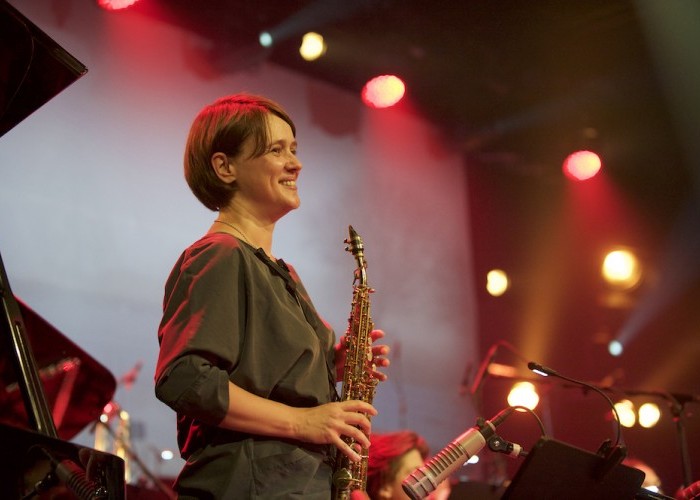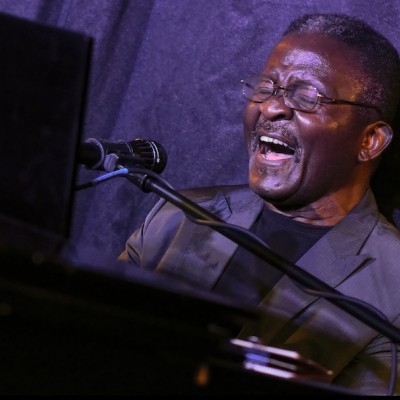Mar 18, 2025 3:00 PM
A Love Supreme at 60: Thoughts on Coltrane’s Masterwork
In his original liner notes to A Love Supreme, John Coltrane wrote: “Yes, it is true — ‘seek and ye shall…

Reedist Ingrid Laubrock said she relishes the freedom that comes with recording for independent labels like Relative Pitch and Germany’s Intakt, but remains skeptical of the music industry’s digital shift.
(Photo: Helmut Berns)Less and less, you dole out a buck per cut, $10 per album; more and more, you access a streaming service for a nominal few each month. Or just play music for free and let ads assail you.
The streaming model’s hardly sustainable for pop acts whose tracks are digitally spun thousands of times a month. For jazz players and those who’ve come to be called “creative musicians,” the economics are even more disastrous.
“A drastic amount of money has been removed from the system through the devaluation of intellectual property rights,” said William Brittelle, co-founder and artist at New Amsterdam Records, a nonprofit label specializing in work by ambitious composers and performers of no fixed genre. But you know the old saw about crisis and opportunity. “Now, there’s not really an excuse not to do what you want to do, because everything is so difficult.”
New Amsterdam releases tend toward the unclassifiable, like the sui generis John Hollenbeck Large Ensemble album All Can Work, on which Billy Strayhorn, Steve Reich and Cary Grant’s LSD habits all provide touchstones. “There’s like five hyphens describing any project,” Brittelle said. And what it costs to create the music is wildly variable. What it costs to buy it is more concrete: For unlimited streams and downloads on the artist-friendly music site Bandcamp, in formats and bitrates from MP3 to Flac and AIFF, All Can Work runs $8 for about 70 minutes of music.
“We need to try to help our audience understand that the primary income-earning cycle of a project needs to be in the run-up to the release, not post-release,” Brittelle said.
So, New Amsterdam and others are experimenting with something like a patronage model, in this case a subscription service: $75 for digital downloads of a year’s worth of new releases from the label, downloadable releases from the back catalog, plus subscriber-exclusive recordings.
“The costs that our artists incur—the production cost, the commission cost—everything is upfront. That’s where they need help, and there is not enough master-oriented income on the other end to offset that. That’s where patronage comes in.”
New Amsterdam, like other upstart labels and many creative musicians, are banking on an audience not of streamers, but of supporters. Trumpeter and composer Dave Douglas also has embraced the subscription model, as well as the Bandcamp platform. Douglas founded Greenleaf in 2006—not long after completing his contract with RCA and at a perilous time for the music business.
“Everyone was saying ‘Oh, the industry is dying now, and you just started your label,’” Douglas recalled. “To me, it seemed more like a moment of opportunity for artists.”
Greenleaf has released LPs from players like Rudy Royston, Linda May Han Oh, Nicole Mitchell and Donny McCaslin. And Douglas has seized freedom for himself, too. In December 2006, independence (and online distribution) offered him the chance to make available every set that his longstanding quintet played during a week at the Jazz Standard, more than 12 hours of music. The bandleader’s ostensibly revisiting the idea for his Brazen Heart Live At Jazz Standard, a four-disc set with saxophonist John Irabagon, pianist Matt Mitchell, bassist Oh and drummer Royston. He’s also recently released UPLIFT: Twelve Pieces For Positive Action In 2018, a subscriber-only offering with a band that includes saxophonist Joe Lovano, guitarists Mary Halvorson and Julian Lage, bassist Bill Laswell, drummer Ian Chang.
“Every set is different,” Douglas said about that earlier set of live recordings. “My quintet was playing 50 tunes from memory that I’d written over the years; most we only played once in the course of the week. After the first night, I came home and was like, ‘I don’t think I can do this, this is a really bad idea.’ But I got up the next day and people around the world had already started to download it.”
It’s $100 to stream or download all 79 tracks of Douglas’ 2006 Live At The Jazz Standard via Bandcamp, something like the going rate of pop music. But with patronage the math gets trickier: You can download Live At The Jazz Standard, as well as 60-plus additional Greenleaf releases for the price of an annual subscription, which starts at $75. At some point, the question stops being about the economics of the music and becomes about the sad truth of time. Would a listener even have time to explore it all? Besides the live Douglas stuff, there’s Royston’s Flatbed Buggy, Greg Ward’s large ensemble work Touch My Beloved’s Thought and dozens of other recordings.
With his subscription model, Douglas has managed to summon in his fans both a sense of being a partner and the promise of other site’s here’s-everything-ever-recorded abundance. Pigging out neither is cost prohibitive, nor exploitative.
OTHER TOP-NAME JAZZ ARTISTS have moved online, too. Saxophonist and composer Rudresh Mahanthappa sells MP3s of his latest release, Agrima, on his own website for $2.50, and Bill Frisell offers 22 live recordings on his site, most at $10.99 for MP3s or $13.99 for higher quality downloads. The saxophonist and composer Ingrid Laubrock, meanwhile, relishes the freedom that comes with recording for independent labels like Relative Pitch and Germany’s Intakt, but remains skeptical of the music industry’s digital shift.

“This is one of the great gifts that Coltrane gave us — he gave us a key to the cosmos in this recording,” says John McLaughlin.
Mar 18, 2025 3:00 PM
In his original liner notes to A Love Supreme, John Coltrane wrote: “Yes, it is true — ‘seek and ye shall…

The Blue Note Jazz Festival New York kicks off May 27 with a James Moody 100th Birthday Celebration at Sony Hall.
Apr 8, 2025 1:23 PM
Blue Note Entertainment Group has unveiled the lineup for the 14th annual Blue Note Jazz Festival New York, featuring…

“I’m certainly influenced by Geri Allen,” said Iverson, during a live Blindfold Test at the 31st Umbria Jazz Winter festival.
Apr 15, 2025 11:44 AM
Between last Christmas and New Year’s Eve, Ethan Iverson performed as part of the 31st Umbria Jazz Winter festival in…

“At the end of the day, once you’ve run out of differences, we’re left with similarities,” Collier says. “Cultural differences are mitigated through 12 notes.”
Apr 15, 2025 11:55 AM
DownBeat has a long association with the Midwest Clinic International Band and Orchestra Conference, the premiere…

“It kind of slows down, but it’s still kind of productive in a way, because you have something that you can be inspired by,” Andy Bey said on a 2019 episode of NPR Jazz Night in America, when he was 80. “The music is always inspiring.”
Apr 29, 2025 11:53 AM
Singer Andy Bey, who illuminated the jazz scene for five decades with a four-octave range that encompassed a bellowing…